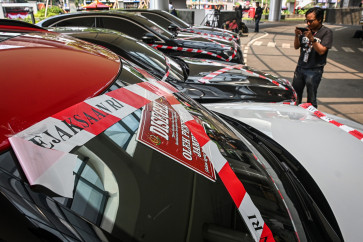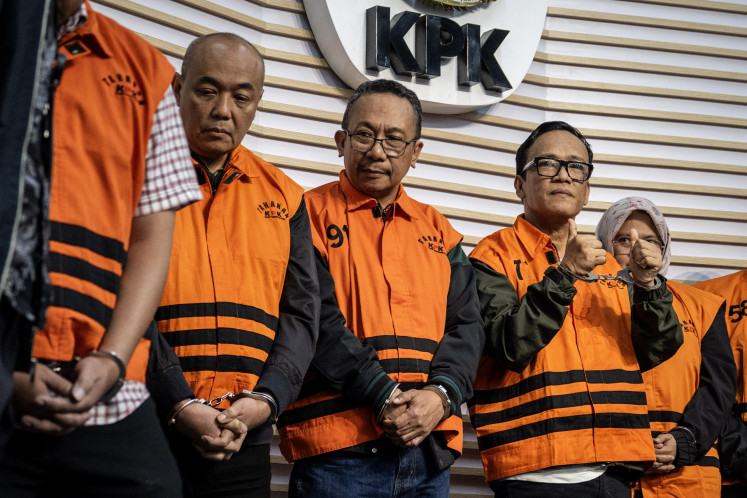Popular Reads
Top Results
Can't find what you're looking for?
View all search resultsPopular Reads
Top Results
Can't find what you're looking for?
View all search resultsW. Kalimantan’s international port to begin operations in 2020
New freight hub: Early-stage construction takes place on the Kijing Seaport Terminal project in Mempawah, Pontianak, West Kalimantan, in September, covering work on the docks, port management area, causeway, container yard and other facilities
Change text size
Gift Premium Articles
to Anyone
N
ew freight hub: Early-stage construction takes place on the Kijing Seaport Terminal project in Mempawah, Pontianak, West Kalimantan, in September, covering work on the docks, port management area, causeway, container yard and other facilities. (JP/Riza Roidila Mufti)
A thick grey smog was covering the air and sky above the construction site of the Kijing Seaport Terminal in Sungai Kunyit village, Mempawah, West Kalimantan in late September. However, despite the pollution over Kijing Beach that day, the construction of the port was unaffected.
The initial stage of the construction of the port, one of the government’s national strategic infrastructure projects, is underway and scheduled for completion in 2020.
Located 80 kilometers from Pontianak, the world-class port is being built as an expansion of the existing Dwikora Port in Pontianak, which has begun to suffer from a lack of capacity.
The Indonesia Port Corporation's (IPC) senior vice president for strategic project management, Zuhri Iryansyah, said the Kijing port would be developed as an ‘‘ultimate’’ seaport terminal, using the latest port technology.
“We plan to make the Kijing Seaport an ultimate terminal. It will have a jetty 5 km in length and a depth of about 15 meters, so it will become a world-class seaport that can accommodate many big ships in the future,” said Zuhri told a group of journalists visiting the project on Sept. 18.
For a total cost of about Rp 14 trillion ($988.4 million), the new Kijing Port is to have a container terminal with capacity of up to 2 million 20-foot equivalent units (TEU), much bigger than the Dwikora Port's capacity of 300,000 TEUs. The new Kijing Port would occupy an area of about 200 hectares, much bigger than Dwikora Port, which only sits on 10 ha.
The ongoing project is the initial part of the port development, which comprises the construction of a one-km-long jetty and container terminal with a capacity for 500,000 TEUs. The initial project covers an area of 52 ha. IPC plans also to build industrial zones near the port.
“We started the initial stage of the port development in 2018 and today the construction, on paper, has reached 23 percent but in the field it is 30 percent. We aim to finish the initial stage by mid-2020,” he said.
The Kijing Port is located on Kalimantan’s western coast, which faces Singapore. Zuhri said the location is very strategic as a hub for the shipment of commodities or goods to and from Far East countries such as China, Hong Kong, Japan and South Korea.
For West Kalimantan, the Kijing Port, which is to become the main gate for the shipment of commodities and goods from Kalimantan to other parts of the world, is expected to create a multiplier effect on the local economy, West Kalimantan Governor Sutarmidji said.
“West Kalimantan is one of the biggest palm oil producers in Indonesia, but the province does not receive even a single rupiah from the exports of the commodity. How could it happen? Since no palm oil exports are shipped through West Kalimantan, the province does not receive any earnings from such export commodities,” he said, adding that none of the commodities from the province such as palm oil can be exported through the province because none of the local ports have met standards for international shipment.
West Kalimantan is among the top 10 biggest producers of crude palm oil (CPO) in Indonesia. According to data from the Agriculture Ministry, in 2018 the province produced 2.9 million tons of CPO. In 2017 and 2016, the production reached 2.78 million tons and 2.19 million tons respectively, making West Kalimantan the sixth biggest CPO producer in Indonesia.
However, Sutarmidji said that for years, the CPO produced by the province has been exported to other countries through Dumai Port in Riau, Belawan Port in North Sumatra or the Tanjung Priok Port in North Jakarta. The Dwikora Port in Pontianak has not been designed for the shipment of export commodities.
“In the future, the Kijing Port can be used for the shipment of export commodities such as CPO, alumina and bauxite,” said Sutarmidji. With the operation of the Kijing Port, Sutarmidji estimates that West Kalimantan could potentially earn Rp 500 billion in export duties.
The general manager of IPC's Pontianak branch, Adi Sugiri, said that the use of the Kijing Port to export commodities from the province could cut logistics costs by about 30 percent. Giri said the shipment costs from the province were so high because of the high transit costs from the province to Indonesia’s international ports such as on Java or Sumatra.
“The shipment costs from Jakarta to Medan are higher than from Jakarta to Tokyo,” said Adi.
Adi said the existence of the Kijing Port would also solve the undercapacity problem at Dwikora Port. In 2019, Dwikora Port is to expanded to increase its container receiving capacity from 300,000 to 311,000 TEUs.










